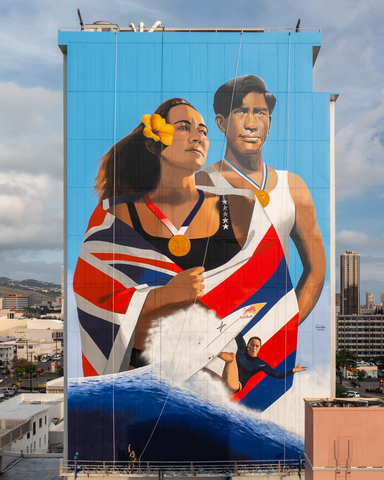Native Hawaiian Olympians Honored in 100-Foot Mural in the Birthplace of Surfing on the Heels of the Sport’s Olympic Debut
Native Hawaiian Olympians Honored in 100-Foot Mural in the Birthplace of Surfing on the Heels of the Sport’s Olympic Debut
The mural depicts gold medalists Carissa Moore and Duke Kahanamoku
The mural "He‘e Nalu: Two Hawaiian Olympians" was created by artist Kamea Hadar and illustrates dual portraits of Carissa Moore and Duke Kahanamoku. Moore made history by becoming the first women’s Olympic gold medalist in surfing this year as the sport made its debut at the Tokyo 2020 Summer games. Duke Kahanamoku was the first Native Hawaiian Olympian – a two-time silver medalist and three-time gold medalist in swimming – and is also the waterman credited with sharing the sport of surfing across the globe. The massive 100-foot by 60-foot mural depicts both figures proudly wearing their gold medals won over a century apart. The five stars on Moore’s shoulder represent her five world titles in the World Surfing League. Tucked behind her ear she wears the Ilima, or yellow hibiscus, the state flower of Hawaii. At the bottom of the piece is an image of Moore surfing, illustrating her prowess in technical surfing that characterizes the modern-day progression of the sport. (Photo: Business Wire)
HONOLULU--(BUSINESS WIRE)--A building-size mural celebrating two native Hawaiian Olympians was unveiled in Honolulu, Hawaii — the birthplace of surfing — just as Oahu’s North Shore surf season begins. The mural – He‘e Nalu: Two Hawaiian Olympians – was created by artist Kamea Hadar and illustrates dual portraits of Carissa Moore and Duke Kahanamoku. Click here for images of the mural in addition to photos and b-roll from the Dec. 11 event celebrating its completion. Moore made history by becoming the first women’s Olympic gold medalist in surfing this year as the sport made its debut at the Tokyo 2020 Summer games. Yet, the dream to have surfing represented on the Olympic stage predates Moore’s victory by more than 100 years. It was a dream first pursued by Duke Kahanamoku - the first Native Hawaiian Olympian and the waterman credited with sharing the sport across the globe. Kahanamoku, a two-time silver medalist and three-time gold medalist in swimming, in his first Olympic appearance in 1912 in Stockholm, Sweden expressed to the International Olympic Committee that surfing belonged in the games. Over a century later this dream has been realized and Moore, a Native Hawaiian herself, claimed the inaugural gold.
The massive 100-foot by 60-foot mural depicts both figures proudly wearing their gold medals won over a century apart. At the bottom of the piece is an image of Moore surfing, illustrating her prowess in technical surfing that characterizes the modern-day progression of the sport.
“I wanted the focal point of the mural to depict Carissa and Duke standing solemnly side by side,” said Hadar, the artist behind the mural and co-lead director of POW! WOW! Worldwide. “My intention was to go deeper than highlighting their accomplishments as athletes. As native Hawaiians in the Olympics they broke through cultural barriers to change the world for the better.”
Moore is also shown with the Hawaii state flag draped around her shoulders — the flag that she competes under on the World Surf League (WSL) circuit. The WSL allows surfers from Hawaii to fly the state flag as opposed to the United States flag in solidarity with Hawaii being the birthplace and cultural home of the sport. During the Olympic games this distinction was not recognized. “Although Carissa was not able to surf under the Hawaiian flag, I felt it was important to depict her with the flag of her home state to rightly recognize the sport of surfing as having its roots in Hawaii,” added Hadar.
Moore learned how to surf at the age of four on the same beaches of Waikiki that Kahanamoku had surfed decades before. In 2008 at age 16, she became the youngest champion of the Triple Crown of Surfing. In 2021 Moore also won her fifth WSL world title.
“I’ll be honest, seeing my face on the side of a building is kind of overwhelming but I am so honored and humbled to be painted alongside one of my greatest heroes, Duke Kahanamoku by one of the most amazing artists, Kamea Hadar,” said Moore. “I loved Kamea’s vision to create a piece that acknowledges the past and all those who have come before, celebrate the moment and how far we’ve come and inspire the next generation of Hawaiians that anything is possible and to do it with aloha.”
For more information visit www.KameaHadar.com.
Contacts
Lance Aquino
lance@strykerweiner.com

